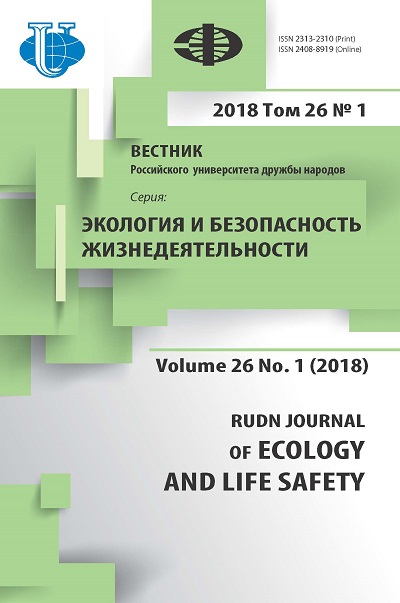USING RUSSIAN REMOTE SENSING DATA FOR STUDING THE DYNAMIC OF ECOLOGICAL AND RESOURSE POTENTIAL RECOVERY OF FORESTS AREA AFTER THE IMPACT OF FOREST FIRES
- Authors: Grigorets E.A.1, Kapralova D.O1, Permitina L.I.2
-
Affiliations:
- Peoples’ Friendship University of Russia
- NTs OMZ AO «Rossiiskie kosmicheskie sistemy»
- Issue: Vol 26, No 1 (2018)
- Pages: 52-62
- Section: Geoecology
- URL: https://journals.rudn.ru/ecology/article/view/19264
- DOI: https://doi.org/10.22363/2313-2310-2018-26-1-52-62
Cite item
Full Text
Abstract
The use of remote sensing data for determining the fire situation is shown, as for the monitoring of fire situations and assessment of pyrogenic forest distraction. Studies were conducted on the use of long-term satellite observations to monitor and evaluate the dynamics of ecological and resource potential recovery of the areas affected by forest fires and are based on the assessment of the amount of lost biomass and the rate of vegetation recovery. The ability to monitor the dynamics of vegetation recovery on damaged fire areas are encouraged to implement on the basis of the use of vegetation indices based on spectral properties of vegetation. The proposed method makes it possible to assess the state and environmental and climatic characteristics of the vegetation biomass of the territory and its productivity. It shows the results of remote sensing data from Russian and foreign satellites, obtained in the periods from 2009 to 2013. There are given maps of vegetation index constructed for the studied forestry and the histogram index changes, which assesses the amount of biomass of forest areas.
About the authors
Elizaveta Andreevna Grigorets
Peoples’ Friendship University of Russia
Author for correspondence.
Email: 5977749@mail.ru
postgraduate student of Ecology monitoring and forecasting department, RUDN University
8/5, Podol’skoe shosse, Moskow, 113093, Russian FederationDaria O Kapralova
Peoples’ Friendship University of Russia
Email: dorris@yandex.ru
senior lecturer Ecology monitoring and forecasting department, RUDN University
8/5, Podol’skoe shosse, Moskow, 113093, Russian FederationLarisa Ivanovna Permitina
NTs OMZ AO «Rossiiskie kosmicheskie sistemy»
Email: permitina@ntsomz.ru
Leading Researcher NTs OMZ JSC “Russian Space Systems”.
51/25, Dekabristov str., Moskow, 127490, Russian FederationReferences
- Grigorets E.A. Comparative analysis of species and methods for monitoring forest fires in Russia. Molodoi uchenyi. 2015. № 8. S. 379—381.
- Brown James K., Smith Jane Kapler, eds. 2000. Wildland fire in ecosystems: effects of fire on flora. Gen. Tech. Rep. RMRS-GTR-42-vol. 2. Ogden, UT: U.S. Department of Agriculture, Forest Service, Rocky Mountain Research Station. 257 p.
- Ukrainskiy P.A. Dynamics of spectral properties of overgrown grassy fires Modern problems of remote sensing of the Earth from space. 2013. P. 10. № 4. P. 229—238.
- Rozhkov Yu.F., Kondakova M.Yu. Evaluation of the forest restoration process dynamics after a fire, using the interpretation of space images. Modern problems of science and education. 2013. No. 5 [digital resource]. URL: https://science-education.ru/ru/article/view?id=10434 (date of access: 14.12.2016).
- Forest resources. Ministry of ecology and natural resources of Nizhny Novgorod region [digital resource]. Available at: http://mineco-nn.ru/File/05_Лесные_ресурсы.doc (date of access: 02.12.2016).
- Cherepanov A.S., Druzhinina E.G. The spectral properties of vegetation and vegetation indices. Geomatika. 2009. № 3(4). S. 28—32.
- Dubinin М. Teoretical base of using NDVI [digital resource]. URL: http://gis-lab.info/qa/ndvi. html (date of access: 02.12.2016).
- Cherepanov A.S. Vegetation indices. Geomatika. 2011. № 2(3). S. 98—102.
- Forests of Nizhny Novgorod region [digital resource]. URL: http://autotravel-nn.ru/tags/les/ (date of access: 14.12.2016).
- IIASA’s Global Forest Database (GFD) [digital resource]. URL: http://www.iiasa.ac.at/web/ home/research/modelsData/GlobalForestDB.en.html (date of access: 14.12.2016).
















